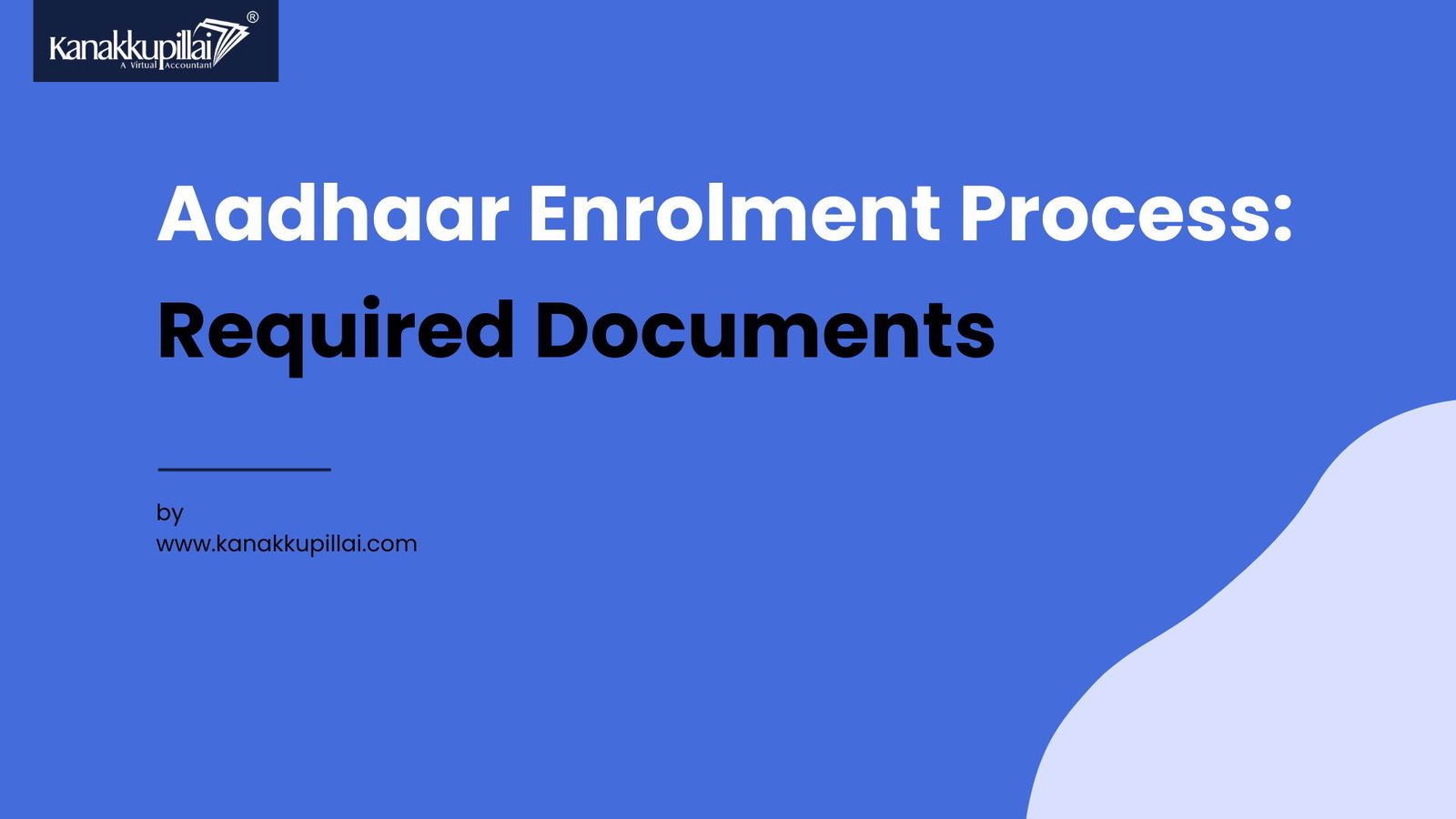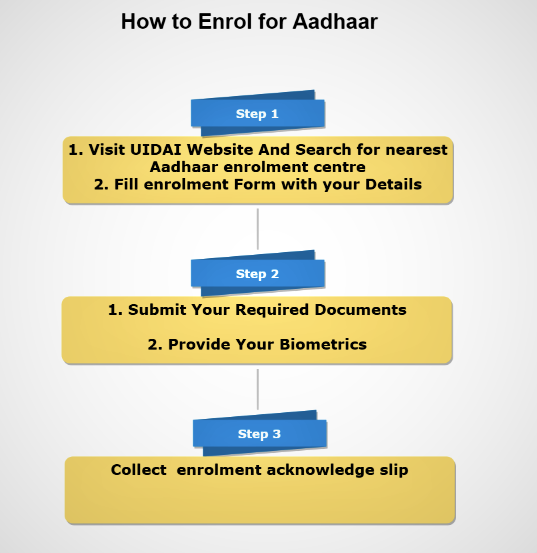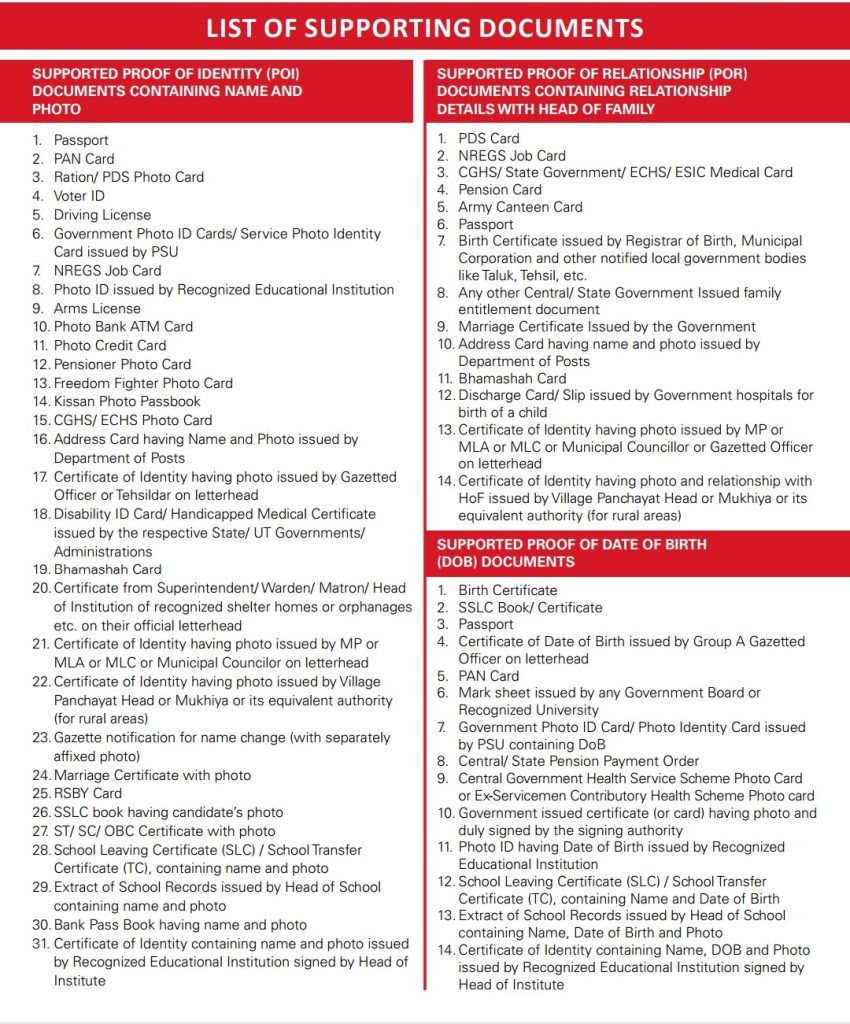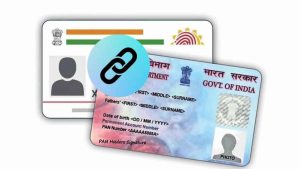Aadhaar Enrolment Process: Required Documents and Guidelines

The Aadhar card is a special identification number linked to the cardholder’s fingerprint and iris scan. The Unique Identification Authority of India is the organization that issues Aadhar cards. However, it serves as a means of proving identity, not citizenship.
After completing the verification process, the UIDAI grants Indian citizens a 12-digit unique number, which is the code on the card. Indian citizens of any age, gender, or religion may freely sign up to receive an Aadhaar card.
Each Indian resident’s Aadhaar number provides them with the following benefits:
- Proof of identity
- Proof of address
- Access to government subsidy
- Eligibility to open and operate bank accounts
- Processing and filing income tax returns
- Phone connection
- Gas connection
- e-know your customer (eKYC) for mutual fund investments
- Aadhaar for eKYC
The government has reportedly saved nearly US$9 billion thanks to the Aadhar card, according to Nandan Nilekani, the first UIDAI chairman. False and duplicate entries are removed from the beneficiary and employee lists thanks to the unique Aadhaar number. This aids in the eradication of financial distribution system fraud.
Basic Requirements for Aadhaar Enrollment
Eligibility for Aadhaar
The following information explains who is eligible for an Aadhaar card:
Any Indian citizen, including infants and minors, can obtain Aadhaar cards. Baby Aadhaar is for children under five, whereas the Aadhaar card is for adults.
Foreign nationals and non-resident Indians (NRIs) who have been in India for over a year are eligible for the Aadhaar. For NRIs with Indian passports, it is suggested that they provide an Aadhaar card immediately upon arrival rather than 180 days later.
Age Limit for Aadhaar Enrollment
There is no minimum or maximum age to apply for an Aadhaar card.
Even you can apply for an Aadhaar card for a newly born baby (necessary documentation is required).
Aadhaar is neither an Aadhaar for adults nor an Aadhaar for children, according to the UIDAI. Citizens can apply for it and get it at various ages. But if you obtained your Aadhaar card before turning 15, you must have your photo and biometrics taken again once you reach that age.
What is the Aadhaar Enrollment Procedure?

Steps to enrol for an Aadhaar card
- Visit the official Aadhaar website to locate an Aadhaar enrollment facility.
- Complete the form with the necessary information.
- Submit the necessary paperwork.
- Provide your biometric data (fingerprint and iris scan).
- Get the acknowledgement of the enrollment slip.
- Enrollment in Aadhaar is free and voluntary.
There are Three ways to Aadhaar Enroll, as follows:
1) Document-based
- One valid POI document and one valid POA document must be submitted.
2) Head of Family (HOF)-based
- The Head of Family (HOF) may introduce family members using documents that prove their familial ties (POR).
3) Introducer-based
- An introducer’s service may be used without valid POI and POA documents. An introducer is a person chosen by the registrar, and they must have a current Aadhaar number.
- Please complete the enrollment form at the enrollment centre with your personal information. We’ll also take your photo, fingerprints, and iris scan as part of the enrollment process. You can examine the information you provided during enrollment and make changes. You will obtain an acknowledgement slip with an enrollment number and other details acquired during enrollment. Within 96 hours of enrollment, any changes to the enrollment information may be made by visiting the enrollment centre with the acknowledgement slip.
- You only need to enrol once; repeated enrollments will be rejected unless the UIDAI advises otherwise.
- The waiting period for Aadhaar after receiving resident data packets via classless inter-domain routing (CIDR) may range from 60 to 90 days.
Based on what we’ve covered thus far, we believe this blog would interest anyone interested in learning more about the complete Aadhaar enrolment process.
If you want to enrol for Aadhaar, Kanakkupillai is here to help you! We understand the importance of Aadhaar and how it can benefit you in various aspects of life.
Documents Required for Aadhaar Enrollment

Indian individuals receive an Aadhaar card after providing crucial biometric data. The UIDAI, the issuing government organization, requests a list of documents to confirm the accuracy of applicants’ information and make this process foolproof.
Aadhaar cards are only generated after the necessary documentation has been completed. The list of Aadhaar card documents you must provide when applying for or enrolling for this card is below.
- Identity proof
- Address proof
- Date of birth proof
- Proof of relationships
Proof of Identity Documents
The identity documentation that supports your Aadhaar card application is crucial. The presence of a photo and a name on the card are the main requirements for such Aadhar card identity documents.
You can select any documents from the list below when visiting an Aadhaar enrollment centre.
- Voter ID
- PAN card
- Ration card
- Passport
- Driving license
- Photo ID issued by the government
- Bank ATM card with photo
- NREGS job card
- ECHS/CGHS card with photo
- Arms license
- Photo ID issued by a registered educational institution
- Credit card with photo
- Kissan photo passbook
- Photo certificate issued by a gazetted officer on letterhead
- Pensioner card with photo
- Freedom fighter card
- Address card issued by the Department of Posts
- Handicapped or Disability ID Card or medical certificate
You can choose any of these as proof of identity for an Aadhaar card. Also, you have to furnish proof of address.
Proof of Address Documents
Aadhaar card documentation also comprises proof of address, which must at least include your name and address. Also, as the Aadhar card will only be mailed to that location, please take caution while submitting documentation supporting your address.
The list of documents that can serve as proof of an Aadhaar card’s address is provided below.
- Ration card
- Passbook
- Bank statement
- Insurance documents
- Utility bills like electricity and telephone bill
- Address certificate signed by a registered company on letterhead
- Arms license
- Post office passbook
- Voter ID
- Property tax receipt
- Government photo ID card
- Address card issued by the Department of Posts
- Gas connection bills (not older than three months)
- Disability ID card
- Registration certificate of vehicles
- Rent/lease/sale agreement
- Domicile certificate of caste certificate with a photograph
- NREGS job card
- Freedom fighter card
- Kissan passbook
- Marriage certificate
- Address certificate issued by village Panchayat head—for rural areas
- Accommodation allotment letter from the state or central government (not older than three months).
Proof of Date of Dirth Documents
You must provide documentation proving your identity, residence, and date of birth.
Choose any of the following:
- Birth certificate
- Passport
- SSC certificate
- PAN card
- Mark sheet issued by a government board or university
- Central pension payment or state pension payment order
- Date of a birth certificate signed by a gazetted officer on a letterhead
Carry the original copy of the document you want to submit along with its photocopy
Guidelines for Document Validity/Verification
- Confirm that the resident has original documentation so it may be verified. Copies of documents attested to or certified by a public notary or gazetted officer will be accepted in cases where the originals are not readily available.
- The resident’s Aadhaar enrollment paperwork must be on the list of authorized documents. Under http://www.uidai.gov.in/images/FrontPageUpdates/valid documents list.pdf, you can find a list of the documents that UIDAI has authorized as proof of identity (POI), date of birth (DOB), proof of address (POA), and proof of relationship (PoR).
The list of accepted papers may be amended and expanded as necessary by the UIDAI and registrars.
- Annexure 1 includes a sample letter of certification. This format is for certifications issued by authorities or institutions (only those recognized in the UIDAI’s valid list of documents).
- The verifier may decline the verification if he or she believes the documents are fake or manipulated. If the verifier declines to verify the provided documents, he or she should briefly note their reasoning on the enrollment form. Suppose the verifier declines to verify with justification or sends the resident away without noting any justifications. In that case, the resident may file a complaint with a designated authority or cell established by the registrar at the block level.
- Check the name, birthdate, address, and relationship information against the corresponding POI, DoB, POA, and PoR records.
1) Name
- POI requires a document with the resident’s name and picture. Make sure the document has both.
- Any submitted POI documents that do not include the resident’s photo will not be recognized as valid POIs. Older images are permitted on paperwork to be inclusive and free of harassment. The POI with and without a photograph is shown in the illustration below. The illustration with the photo is accurate.
- Inquire about the resident’s name to verify the Aadhaar name on the paperwork. This is done to make sure the resident is supplying their documentation.
- The person’s name should not contain salutations or titles like Mr., Mrs., Major, Retd., etc. The illustration below shows two completed enrollment forms, one with salutations and the other without. The answer that omits the salutation is correct.
- It is crucial to carefully and correctly write the person’s name. As an illustration, the answer can claim to be V. Vijayan, whereas, in reality, his full name is Venkatraman Vijayan. Similarly, R. K. Srivastava might go by Ramesh Kumar Srivastava. A female enrollee can use K. S. K. Durga instead of her full name, Kalluri Surya Kanaka Durga. Find out from her or him how to expand her or his initials, then confirm this in the supplied documentary evidence.
- The resident’s declared name may be recorded if there is a discrepancy between it and the name on the document (POI) restricted to spelling and/or the order of the first, middle, and last names.
- The enrollee’s full name should be noted if the same name appears differently on two documentary documents the enrollee has provided (i.e., with initials and the full name).
- Sometimes, the names of the babies and kids haven’t been decided. By emphasizing to the enrollee the need to capture the individual’s name for unique identification number (UID) allocation, try to learn the child’s desired name. When supporting documentation for POI is unavailable, the name should be entered with the introducer’s help.
2) Date of Birth
- A resident’s date of birth must have the appropriate fields for the day, month, and year.
- The date of birth is regarded as “verified” if the resident produces documentary proof. The term “declared” refers to a resident who announces their date of birth without providing any supporting documentation.
Just age is recorded when the resident cannot provide a precise date of birth, and only age is provided by the resident or guessed by the verifier. In this situation, the software automatically calculates the user’s birth year.
The verifier should review the item on the enrollment form to ensure the resident has accurately “confirmed” or “declared” their date of birth or entered age.
3) Residential Address
Make sure the name and address are on the POA. The verifier should ensure that the names in the POA and POI documents are identical. If the only variation between the names is the spelling and/or the order of the first, middle, and last names, then the POI and POA documents might have different names.
4) Relationship Details
- Providing the “name” and “EID or UID” of a parent or legal guardian is required for children under five. While enrolling youngsters, parents and guardians must present their acknowledgement or UID letter (or they can be enrolled together). Verify the parent’s name and guardian’s EID and UID.
- In the case of an adult, the information on a parent or spouse will not be verified. These are solely kept on file for internal use.
5) Mobile Number and Email Address
These optional fields must be filled out if the enrollee has them and is willing to offer them. The verifier can explain to the resident how important these fields are. If necessary, such as in the case of returned mail, the UIDAI Aadhaar may contact the resident using this information.
Common Reasons for Document Rejection
Some of the main causes of rejection at an Aadhaar enrollment centre include the following:
- The name entered in violation of the UIDAI guidelines
- The photo in the update request does not match the one on the Aadhar card.
- Based on a snapshot, the age seems off.
- Relationship mismatch
- The resident’s information does not match the POI, POA, POR, or POB paperwork.
- The attached document from a different party
- Just attached the enrollment paper or consent slip.
- Judging from the picture, the age appears to be off (e.g., age 5 for an adult photo).
- Many photographs feature various individuals.
- The image should appear to have been captured via a camera at the moment of enrollment, making the resident appear in a live photograph. It shouldn’t appear taken from a hard copy of the photo (such as a passport photo), a monitor, or a mobile device.
- No offensive or impertinent language should be used in the enrollment information.
- Inconsistent document names
- The scanned document, not the original
- Inconsistent demographic data (document data does not match with entry data)
The status “This enrollment has been refused due to data or processing error” may appear if any of the issues above are present in your Aadhaar enrollment application. To re-enroll, please go to an enrollment center.
Importance of Accurate and Valid Document Submission
You must complete an application form available at the enrollment centre and submit it with supporting documentation, including a document proving your identity, address, relationship, and date of birth. Further, 31 POI, 44 POA, 14 POR, and 14 DOB documents are accepted by the UIDAI. See the list of supporting papers that are accepted nationally.
The residents must study the information in both English and the local language by gazing at the screen in front of them. Ensure that the information for name, gender, DOB, address, etc. is input accurately. Additionally, make sure the name has no prefixes or suffixes, such as Mr., Mrs., Col., Dr., etc. It is advised to use the entire name rather than initials, so Brij Kumar Sharma should be used instead of B. K. Sharma. Verify if the operator’s photograph is accurate and recognizable.
So, it is evident that only if you present legitimate documents at the enrollment centre will your Aadhaar enrollment be effective.
Conclusion
The Aadhaar enrollment process involves going to an enrollment centre, filling out an application, providing demographic and biometric information, providing identification and address documentation, and receiving an acknowledgement slip with an enrollment ID. The benefits of enrolling in Aadhaar include the following:
- Enrollment in Aadhaar is free of charge.
- With your evidence of identity and proof of address, you can visit any authorized Aadhaar enrollment centre throughout India.
- The UIDAI process accepts a variety of POI and POA documents. Go at the list of further resources. Election photo ID cards, ration cards, passports, and driving licenses are typical forms of identification and proof of address.
- PAN cards and other photo IDs issued by the government are acceptable as identification documents. The latest three months’ worth of water, energy, and landline phone bills are also included in the paperwork that proves your address.
- Residents may also seek the assistance of introducers at the enrolment facility if no documents are available. The registrar notifies the introducers. Please get in touch with the relevant registrar’s office for more information.
So, if you want to easily enrol for Aadhaar, contact Kanakkupillai today! Don’t miss out on the benefits of Aadhaar.
With our expert guidance, you can easily enrol for Aadhaar without any hassle. Our team will assist you with the necessary documents, fill out the application form, and guide you through enrollment at the nearest Aadhaar centre.
Please Share This Share this content
- Opens in a new window
- Opens in a new window
- Opens in a new window
- Opens in a new window
Kanakkupillai is your reliable partner for every step of your business journey in India. We offer reasonable and expert assistance to ensure legal compliance, covering business registration, tax compliance, accounting and bookkeeping, and intellectual property protection. Let us help you navigate the complex legal and regulatory requirements so you can focus on growing your business. Contact us today to learn more.
You Might Also Like


July 26, 2023

July 10, 2023
Recent Posts







